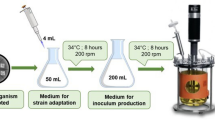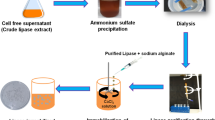Abstract
The aim of this study was to promote the decomposition of gentamicin mycelial residues (GMRs) and removal of antibiotics resistance genes (ARGs) by alkaline hydrothermal treatment (AHT). The treated GMRs were also inoculated with fungi and converted into protein feed by solid-state fermentation (SSF). The conditions of AHT were reaction temperature (140–200 °C), residence time (0–60 min), and NaOH concentration (0–0.6 M). The effects of AHT on GMR organic release and ARGs, as well as on SSF of Candida utilis and Geotrichum candidum, were explored. The results showed that AHT under different conditions significantly reduced the particle size of the GMRs and promoted the release and solubilization of organic matter. However, both C. utilis CFU and G. candidum CFU kept decreasing as the reaction temperature increased. This was attributed to the fact that higher treatment temperatures resulted in the deterioration of nutrients and production of many non-biodegradable substances, which inhibited SSF of GMRs. Extended residence time is more conducive to promoting the release and hydrolysis of polysaccharides from GMRs, which is more suitable for C. utilis SSF. Increasing the concentration of NaOH can promote the release of more proteins in the GMRs, which can better satisfy the demand for high protein concentration in the fermentation matrix of G. candidum. In addition, AHT was able to reduce the abundance of most ARGs by untargeted disruption of gene structure, but it was difficult to remove plasmid gene IncN. High temperature, long residence time, and high NaOH concentration (> 0.4 M) are more favorable for the removal of ARGs. Considering the efficiency of SSF and the removal of ARGs, GMRs’ optimal treatment temperature of AHT was 140 °C. In addition, long residence time is suitable for C. utilis SSF of GMRs and high NaOH concentration is suitable for G. candidum SSF.






Similar content being viewed by others
Data availability
Data will be made available on request.
References
Appels L, Degrève J, Van der Bruggen B, Van Impe J, Dewil R (2010) Influence of low temperature thermal pre-treatment on sludge solubilisation, heavy metal release and anaerobic digestion. Bioresour Technol 101:5743–5748. https://doi.org/10.1016/j.biortech.2010.02.068
Bougrier C, Delgenès JP, Carrère H (2008) Effects of thermal treatments on five different waste activated sludge samples solubilisation, physical properties and anaerobic digestion. Chem Eng J 139:236–244. https://doi.org/10.1016/j.cej.2007.07.099
Burch TR, Sadowsky MJ, LaPara TM (2017) Effect of different treatment technologies on the fate of antibiotic resistance genes and class 1 integrons when residual municipal wastewater solids are applied to soil. Environ Sci Technol 51:14225–14232. https://doi.org/10.1021/acs.est.7b04760
Cai C, Liu H, Wang M (2017) Characterization of antibiotic mycelial residue (AMR) dewatering performance with microwave treatment. Chemosphere 174:20–27. https://doi.org/10.1016/j.chemosphere.2017.01.121
Cai C, Gong P, Wang Y, Wang M, Zhang B, Wang B, Liu H (2018) Investigating the environmental risks from the use of spray-dried cephalosporin mycelial dreg (CMD) as a soil amendment. J Hazard Mater 359:300–306. https://doi.org/10.1016/j.jhazmat.2018.07.038
Cai C, Hua Y, Li H, Li L, Dai L, Liu H, Dai X (2020) Hydrothermal treatment of erythromycin fermentation residue: harmless performance and bioresource properties. Resour Conserv Recycl 161. https://doi.org/10.1016/j.resconrec.2020.104952
Chen C, Huiling L (2018) Application of microwave-pretreated cephalosporin mycelial dreg (CMD) as soil amendment: temporal changes in chemical and fluorescent parameters of soil organic matter. Sci Total Environ 621:417–424. https://doi.org/10.1016/j.scitotenv.2017.11.261
Chen W, Westerhoff P, Leenheer JA, Booksh K (2003) Fluorescence excitation-emission matrix regional integration to quantify spectra for dissolved organic matter. Environ Sci Technol 37:5701–5710. https://doi.org/10.1021/es034354c
Cheng C, Sun J, Zheng F, Lu W, Yang Q, Rui Y (2016) New structures simultaneously harboring class 1 integron and ISCR1-linked resistance genes in multidrug-resistant Gram-negative bacteria. BMC Microbiol 16:71. https://doi.org/10.1186/s12866-016-0683-x
DuBois M, Gilles KA, Hamilton JK, Rebers PA, Smith F (1956) Colorimetric method for determination of sugars and related substances. Anal Chem 28:350–356. https://doi.org/10.1021/ac60111a017
Dwyer J, Starrenburg D, Tait S, Barr K, Batstone DJ, Lant P (2008) Decreasing activated sludge thermal hydrolysis temperature reduces product colour, without decreasing degradability. Water Res 42:4699–4709. https://doi.org/10.1016/j.watres.2008.08.019
Eaton A (2005) Standard methods for the examination of water and wastewater. American Public Health Association, Washington DC
Gong P, Liu H, Wang M, Dai X, Yao J (2020) Characteristics of hydrothermal treatment for the disintegration of oxytetracycline fermentation residue and inactivation of residual antibiotics. Chem Eng J 402. https://doi.org/10.1016/j.cej.2020.126011
Gonzalez A, Hendriks ATWM, van Lier JB, de Kreuk M (2018) Pre-treatments to enhance the biodegradability of waste activated sludge: elucidating the rate limiting step. Biotechnol Adv 36:1434–1469. https://doi.org/10.1016/j.biotechadv.2018.06.001
Jiang M, Song S, Liu H, Wang P, Dai X (2021) Effect of gentamicin mycelial residues disintegration by microwave-alkaline pretreatment on methane production and gentamicin degradation during anaerobic digestion. Chem Eng J 414. https://doi.org/10.1016/j.cej.2021.128790
Kayan B, Gözmen B (2012) Degradation of Acid Red 274 using H2O2 in subcritical water: application of response surface methodology. J Hazard Mater 201–202:100–106. https://doi.org/10.1016/j.jhazmat.2011.11.045
Kruger NJ (2009) The Bradford method for protein quantitation. In: Walker JM (ed) The protein protocols handbook. Humana Press, Totowa, NJ, pp 17–24
Li C, Zhang G, Zhang Z, Ma D, Wang L, Xu G (2015) Hydrothermal pretreatment for biogas production from anaerobic digestion of antibiotic mycelial residue. Chem Eng J 279:530–537. https://doi.org/10.1016/j.cej.2015.05.073
Li HY, Li GX, Wu J, Zhong X, Zhang H (2016) Removal of tetracycline from aqueous solution by hydrothermal method derived titanate nanotubes. Desalin Water Treat 57:19965–19974. https://doi.org/10.1080/19443994.2015.1102765
Liu J, Sheng G, Wang S (2013) Effect of thermal hydrolysis treatment on the characteristics of waste sludge. Environ Poll Control 35:71–76. https://doi.org/10.15985/j.cnki.1001-3865.2013.11.020
Liu Y, Chang H, Li Z, Feng Y, Cheng D, Xue J (2017) Biodegradation of gentamicin by bacterial consortia AMQD4 in synthetic medium and raw gentamicin sewage. Sci Rep 7. https://doi.org/10.1038/s41598-017-11529-x
Magnusson OT, Frey PA (2000) Synthesis and characterization of 3’,4’-anhydroadenosylcobalamin: a coenzyme B12 analogue with unusual properties. J Am Chem Soc 122:8807–8813. https://doi.org/10.1021/ja0013780
Neyens E, Baeyens J (2003) A review of thermal sludge pre-treatment processes to improve dewaterability. J Hazard Mater 98:51–67. https://doi.org/10.1016/S0304-3894(02)00320-5
Partridge S R, Kwong S M, Firth N, Jensen S O (2018) Mobile genetic elements associated with antimicrobial resistance. Clin Microbiol Rev 31. https://doi.org/10.1128/cmr.00088-17
Riedel G, Koehler R, Poerschmann J, Kopinke F-D, Weiner B (2015) Combination of hydrothermal carbonization and wet oxidation of various biomasses. Chem Eng J 279:715–724. https://doi.org/10.1016/j.cej.2015.05.086
Ritala A, Häkkinen S T, Toivari M, Wiebe M G (2017) single cell protein—state-of-the-art, industrial landscape and patents 2001–2016. Front Microbiol 8. https://doi.org/10.3389/fmicb.2017.02009
Saeed M, Yasmin I, Murtaza MA, Fatima I, Saeed S (2016) Single cell proteins: a novel value-added food product. Pak J Food Sci 26:211–217
Sánchez C, Egüés I, García A, Llano-Ponte R, Labidi J (2012) Lactic acid production by alkaline hydrothermal treatment of corn cobs. Chem Eng J 181–182:655–660. https://doi.org/10.1016/j.cej.2011.12.033
Shen Y, Chu L, Zhuan R, Xiang X, Sun H, Wang J (2019) Degradation of antibiotics and antibiotic resistance genes in fermentation residues by ionizing radiation: a new insight into a sustainable management of antibiotic fermentative residuals. J Environ Manage 232:171–178. https://doi.org/10.1016/j.jenvman.2018.11.050
Shen Y, Zhuan R, Chu L, Xiang X, Sun H, Wang J (2019) Inactivation of antibiotic resistance genes in antibiotic fermentation residues by ionizing radiation: exploring the development of recycling economy in antibiotic pharmaceutical factory. Waste Manage (Oxford) 84:141–146. https://doi.org/10.1016/j.wasman.2018.11.039
Stedmon CA, Bro R (2008) Characterizing dissolved organic matter fluorescence with parallel factor analysis: a tutorial. Limnol Oceanogr Methods 6:572–579. https://doi.org/10.4319/lom.2008.6.572
Tan R, Miyanaga K, Toyama K, Uy D, Tanji Y (2010) Changes in composition and microbial communities in excess sludge after heat-alkaline treatment and acclimation. Biochem Eng J 52:151–159. https://doi.org/10.1016/j.bej.2010.08.001
Vavilin VA, Fernandez B, Palatsi J, Flotats X (2008) Hydrolysis kinetics in anaerobic degradation of particulate organic material: an overview. Waste Manage (Oxford) 28:939–951. https://doi.org/10.1016/j.wasman.2007.03.028
Wang M, Zhang B, Cai C, Xin Y, Liu H (2018) Acidic hydrothermal treatment: characteristics of organic, nitrogen and phosphorus releasing and process optimization on lincomycin removal from lincomycin mycelial residues. Chem Eng J 336:436–444. https://doi.org/10.1016/j.cej.2017.12.041
Wang M, Ren P, Liu H, Dai X (2021) Investigating antibiotics, antibiotic resistance genes in soil, groundwater and vegetables in relation to agricultural field - applicated with lincomycin mycelial residues compost. Sci Total Environ 777:146066. https://doi.org/10.1016/j.scitotenv.2021.146066
Wang MM, Zhang B, Wang J, Cai C, Xin YJ, Liu HL (2018) Degradation of lincomycin in aqueous solution with hydrothermal treatment: kinetics, pathway, and toxicity evaluation. Chem Eng J 343:138–145. https://doi.org/10.1016/j.cej.2018.03.008
Wilson CA, Novak JT (2009) Hydrolysis of macromolecular components of primary and secondary wastewater sludge by thermal hydrolytic pretreatment. Water Res 43:4489–4498. https://doi.org/10.1016/j.watres.2009.07.022
Xiao B, Liu C, Liu J, Guo X (2015) Evaluation of the microbial cell structure damages in alkaline pretreatment of waste activated sludge. Bioresour Technol 196:109–115. https://doi.org/10.1016/j.biortech.2015.07.056
Xuan R, Arisi L, Wang Q, Yates SR, Biswas KC (2009) Hydrolysis and photolysis of oxytetracycline in aqueous solution. J Environ Sci Health B 45:73–81. https://doi.org/10.1080/03601230903404556
Xue Y, Liu H, Chen S, Dichtl N, Dai X, Li N (2015) Effects of thermal hydrolysis on organic matter solubilization and anaerobic digestion of high solid sludge. Chem Eng J 264:174–180. https://doi.org/10.1016/j.cej.2014.11.005
Zhang Y, Liu H, Dai X, Cai C, Wang J, Shen Y, Wang P (2019) Variations of physical and chemical properties in relation to erythromycin mycelial dreg dewaterability under heat-activated persulfate oxidation conditioning. Sci Total Environ 687:2–9. https://doi.org/10.1016/j.scitotenv.2019.05.464
Zhang Y, Liu H, Xin Y, Shen Y, Wang J, Cai C, Wang M (2019) Erythromycin degradation and ERY-resistant gene inactivation in erythromycin mycelial dreg by heat-activated persulfate oxidation. Chem Eng J 358:1446–1453. https://doi.org/10.1016/j.cej.2018.10.157
Acknowledgements
The best sincere thanks are given to Tianjin Key laboratory of Biomass Wastes Utilization, Tianjin University, and Interdisciplinary Innovation Lab for Environment and Energy, Tianjin University of Commerce, for their generous help.
Funding
This work was financially supported by the National Key Research and Development Program of China (2022YFD1601104) and the National Natural Science Foundation of China (52370147).
Author information
Authors and Affiliations
Contributions
Guanyi Chen: supervision, project administration, writing—review and editing. Teng Zhou: investigation, conceptualization, validation, writing—original draft, visualization. Yingjin Song: writing—review and editing, supervision, project administration. Beibei Yan: writing—review and editing. Lan Mu: writing—review and editing. Junyu Tao: writing—review and editing. Legeng Pei: writing—review and editing.
Corresponding author
Ethics declarations
Ethics approval
We declare that we do not have human participants, human data, or human issue.
Competing interests
The authors declare no competing interests.
Additional information
Publisher's Note
Springer Nature remains neutral with regard to jurisdictional claims in published maps and institutional affiliations.
Supplementary Information
Below is the link to the electronic supplementary material.
Rights and permissions
Springer Nature or its licensor (e.g. a society or other partner) holds exclusive rights to this article under a publishing agreement with the author(s) or other rightsholder(s); author self-archiving of the accepted manuscript version of this article is solely governed by the terms of such publishing agreement and applicable law.
About this article
Cite this article
Chen, G., Zhou, T., Song, Y. et al. Alkaline hydrothermal treatment of gentamycin mycelial residues: characteristics of disintegration, solid-state fermentation, and antibiotic resistance genes reduction. Biomass Conv. Bioref. (2024). https://doi.org/10.1007/s13399-024-05568-4
Received:
Revised:
Accepted:
Published:
DOI: https://doi.org/10.1007/s13399-024-05568-4




